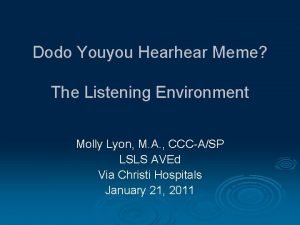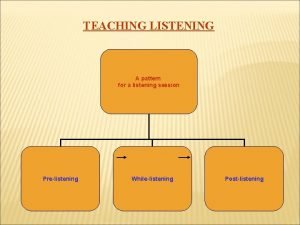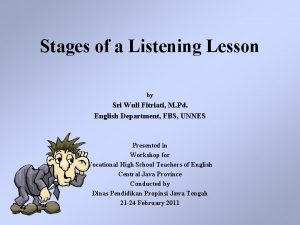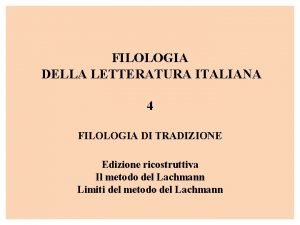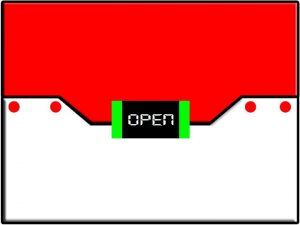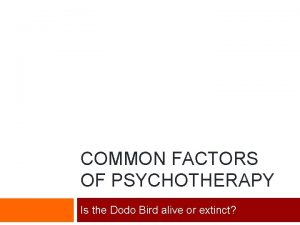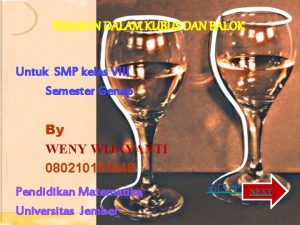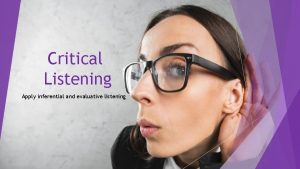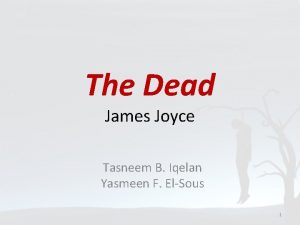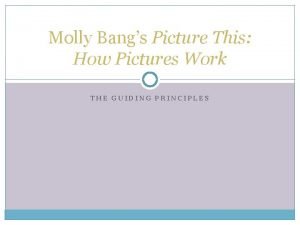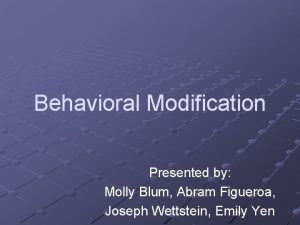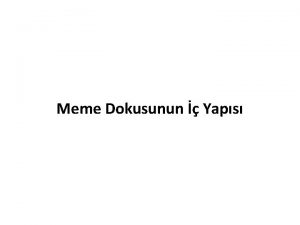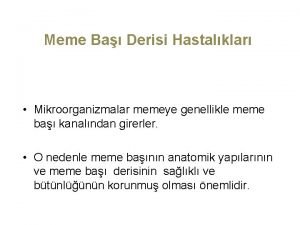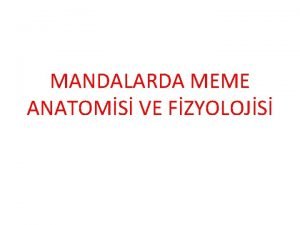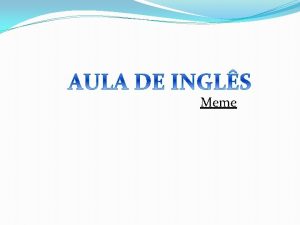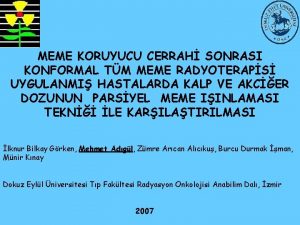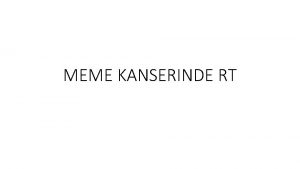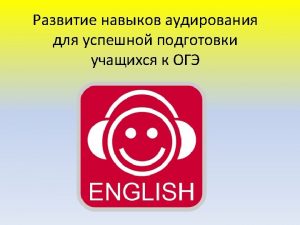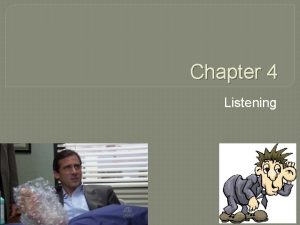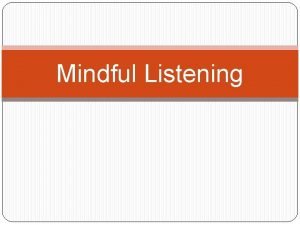Dodo Youyou Hearhear Meme The Listening Environment Molly
























- Slides: 24

Dodo Youyou Hearhear Meme? The Listening Environment Molly Lyon, M. A. , CCC-A/SP LSLS AVEd Via Christi Hospitals January 21, 2011

Objectives Ø Participants will understand the concept of acoustic access and its importance in developing listening skills Ø Participants will become familiar with the environmental factors affecting audition Ø Participants will learn about the application of using FM technology in children

Listening in Children Some Food for Thought… Ø Children do not know what they don’t hear Ø Children do not expend the mental energy to comprehend a degraded, low intensity speech signal comprised of vague, unfamiliar words Ø They do not “go back” in auditory space and try to figure out what they didn’t hear

Ø Children do not hear and process oral language at adult-like levels until around age 13 Ø Language acquisition is a work in progress Ø As language and worldly knowledge increases the less reliant we are on precision hearing Ø Adult: 10% earwork and 90% brainwork Ø Child: 90% earwork and 10% brainwork

Transparency Ø For young listeners, the speech signal must be crystal clear, or “transparent” before true and optimal comprehension and language growth can occur Ø The listening environment is critical to the development of auditory skills

Prerequisites Ø Assuming the child has been fitted with HA/CI Ø Assuming the technology is programmed optimally Ø Assuming the child is wearing the HA/CI all waking hours Ø Little ears are now ready to listen, but…

A Moving Target HEARING LOSS is the only handicapping condition in which the disabling effect is in a constant state of flux. The negative impact of hearing loss can range from being nearly nonexistent to completely rendering an individual’s ability to use audition useless.

What is Acoustic Access? Ø The degree to which spoken language is audible to a child Ø Goal: 100% of the speech signal is audible 100% of the day Acoustic access is under ADULT CONTROL

Environmental Factors Affecting Acoustic Access NOISE DISTANCE REVERBERATION

Background Noise Ø Speech-To-Noise ratio (S/N) is critical Ø Relationship between the primary signal (speech) and background noise. Ø Noise sources include other talkers, heating or cooling systems (HVAC), timers, bells, alarms, computer hums, CD’s, radios, TV’s, wind, pets, etc. Ø Homes are typically quieter than classrooms

Allowable Signal-to-Noise Ratios Ø Adults with normal hearing require a S/N ratio of +6 d. B (approximately twice as loud as background noise) Ø Children with hearing loss require a S/N ratio of +15 to +20 d. B

Distance Ø Sound is degraded as it is propagated through space Ø Rapid Speech Transmission Index (RASTI study, Leavitt and Flexer, 1991) Ø Integrity of a speech signal was measured at 17 different distances

RASTI Results Ø Approximately 4 feet – RASTI score 83% (critical speech information lost = 17%) Ø Approximately 25 feet – RASTI score = 45% Ø Perfect RASTI score was only able to be obtained at a distance of 6 inches from the RATSI transmitter.

Distance and Decibels Ø Ø Double the distance, lose 6 d. B of intensity Every decibel is critical to children with hearing loss Distance Decibel 6” 60 d. B 12” 54 d. B 2’ 48 d. B 4’ 42 d. B 8’ 36 d. B 16’ 30 d. B 32’ 24 d. B

Reverberation (Echo) DEFINITION: Ø The time it takes in seconds from the moment a sound is stopped until the sound level has diminished 60 d. B.


Affects of Reverberation Ø Normal hearing adults can adequately discriminate speech in reverberations times of. 75 to 1 second Ø Children with hearing loss require reverberation times of. 5 seconds Anechoic chamber = 0 seconds Typical classroom = 1. 6 seconds

Reverberation Issues Ø Reverberant sounds mask high frequency sounds Ø Greater absorption of high frequency than low frequency sounds Ø Elongations of vowels Ø Smears transitions Ø Eliminates silent gaps


Boothroyd Demonstration Ø Distance Ø Noise Ø Reverberation Boothroyd, A. , Phonic Ear Sound field tutorial 1. 4 a Room Acoustics and Speech Perception: The Basics

FM Use in Children Ø Significantly improves and maintains speaker’s voice over background noise Ø Eliminates effects of distance Ø Reduces effects of reverberation Ø Child is able to receive consistent speech signal

Listen … Hearing Aid only Hearing Aid + FM Soundfield Demonstration FM mic only

Bibliography American National Standards Institute. (2002). Acoustical performance criteria, design requirements, and guidelines for schools (S 12. 60 -2002). New York: American National Standards Institute (ANSI S 12. 60). Ø Boothroyd, A. (2004). Room acoustics and speech perception. Seminars in Hearing, 25(2), 155 -166. Ø Cole, E. B. , and Flexer, C. (2008). Children with hearing loss: Developing listening and talking birth to six. San Diego, CA: Plural Publishing. Ø Crandall, C. C. , Smaldino, J. J. & Flexer, C. (eds). (2005). Sound-field amplification: Applications to speech perception and classroom acoustics (2 nd ed. ). Clifton Park, NY: Thomson Delmar Learning. Ø

Davis, J. (Ed. ). (1990). Our forgotten children: Hard-ofhearing pupils in the schools. Bethesda MD: Self Help for Hard of Hearing People. Ø Flexer, C. (2004). The impact of classroom acoustics: Listening, learning and literacy. Seminars in Hearing, 25(2), 131 -140. Ø Northern, J. L. , & Downs, M. P. (2002). Hearing in children (5 th ed. ). Baltimore: Lippincott Williams & Wilkins. Ø
 Dodo meme
Dodo meme Pre listening activities
Pre listening activities Stages of a listening lesson
Stages of a listening lesson Saut du meme au meme
Saut du meme au meme Idiografo filologia
Idiografo filologia Meme neguito nicomedes santa cruz
Meme neguito nicomedes santa cruz Dodo akan memberi kado ulang tahun buat desi
Dodo akan memberi kado ulang tahun buat desi Dodo kuşu nesli ne zaman tükendi
Dodo kuşu nesli ne zaman tükendi Dodo passenger pigeon
Dodo passenger pigeon Dodo effect psychotherapy
Dodo effect psychotherapy Dodo bird
Dodo bird Sisi kubus satuan besaran pokok atau satuan besaran turunan
Sisi kubus satuan besaran pokok atau satuan besaran turunan The dinosaur and the dodo bird
The dinosaur and the dodo bird The dodo poem
The dodo poem What is critical listening
What is critical listening Active and passive listening
Active and passive listening Financial environment in business environment
Financial environment in business environment Molly caroland
Molly caroland Books by jerry spinelli
Books by jerry spinelli Marilia garcia
Marilia garcia Generous tears filled gabriel's eyes
Generous tears filled gabriel's eyes Molly bang picture this
Molly bang picture this Molly blum
Molly blum Oj simpson dob
Oj simpson dob Molly nadeau
Molly nadeau
